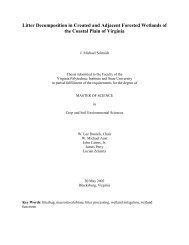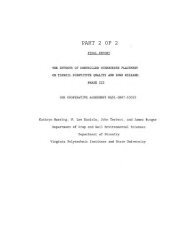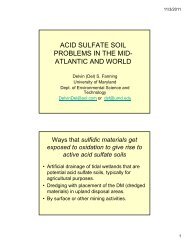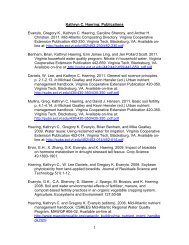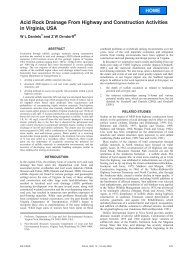Remediation of PAH-Contaminated Soils and Sediments: A ...
Remediation of PAH-Contaminated Soils and Sediments: A ...
Remediation of PAH-Contaminated Soils and Sediments: A ...
You also want an ePaper? Increase the reach of your titles
YUMPU automatically turns print PDFs into web optimized ePapers that Google loves.
donate electrons. The redox potential is positive or high in strongly oxidizing<br />
systems <strong>and</strong> negative or low in strongly reducing systems. Some <strong>of</strong> the common<br />
redox potentials encountered in environmental conditions are presented in Table<br />
5 (Essington, 2004; Bohn et al., 1985):<br />
Table 5. Reduction reactions <strong>and</strong> redox potential for general environmental<br />
conditions.<br />
Reduction Reactions Measured Redox Potential<br />
(V)<br />
O2 → H2O 0.6 – 0.4<br />
NO3 → NO 2- 0.5 – 0.2<br />
MnO2 → Mn 2+ 0.4 – 0.2<br />
FeOOH → Fe 2+ 0.3 – 0.1<br />
SO4 →HS - 0.0 – - 0.15<br />
2H+ → H2<br />
- -<br />
0.15 – 0.22<br />
R → CH4<br />
- -<br />
0.15 – 0.22<br />
In general, for a species to become oxidized, an electron from another species<br />
possessing a higher oxidation state needs to be transferred. Polycyclic aromatic<br />
hydrocarbons have high oxidation states (see Table 6) due to their unique<br />
chemistry previously described. For reference, stable humic acids found in soils<br />
have oxidation potentials near 0.3 – 0.4 V (Stevenson, 1994). Few nonenzymatic<br />
naturally occurring molecules have oxidation potentials that exceed<br />
the oxidation potential <strong>of</strong> <strong>PAH</strong>s. The most common class <strong>of</strong> reactants which<br />
possess oxidation potentials exceeding those <strong>of</strong> the <strong>PAH</strong>s is free radicals. Free<br />
radicals contain an unpaired electron, creating a species having a very high<br />
affinity for electrons (Silberberg, 2006). This leads to very reactive, non-specific<br />
oxidizers, capable <strong>of</strong> attacking benzene rings. (Ferrarese et al., 2008).<br />
33



